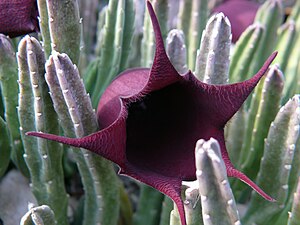Stapelia leendertziae
| Stapelia leendertziae | ||||||||||||
|---|---|---|---|---|---|---|---|---|---|---|---|---|

Stapelia leendertziae |
||||||||||||
| Systematics | ||||||||||||
|
||||||||||||
| Scientific name | ||||||||||||
| Stapelia leendertziae | ||||||||||||
| NEBr. |
Stapelia leendertziae is a species of plant from the subfamily of the asclepiadoideae (Asclepiadoideae). Like many other species of the genus Stapelia (and other representatives of the Stapeliinae) it is also called the carrion flower. The species name honors Miss Reino Leendertz (1869–1965), who collected the type specimen in 1909.
features
Stapelia leendertziae forms stem succulents , dull green to slightly shiny, more or less slender, four-ribbed shoots, the sides of which are strongly concave. The shoots grow bowed-lying to upright and form compact growth forms. The leaflets are about 2.5 mm long and transient. After the leaves fall off, only white, crescent-shaped pockets remain around the leaf base.
The purple-colored flower bud is spherical or elongated oval and apically pointed. It sits on a 2 to 3 cm long flower stalk . The sepals measure 0.6 to 1.2 cm in length. The dark red to purple corolla measures up to 5 cm in diameter and is bell-shaped. The crown tube is densely hairy inside. The crown lobes are about 1 × 1 cm in size, triangular and moderately to strongly curved outwards. The edges are slightly hairy, the tips are covered with horizontal wrinkles. The secondary crown is brown to dark purple in color. The upright, interstaminal side lobes are deeply divided and narrow apically. The staminal side lobes are free, stand upright and are up to about 9 mm long. They are rectangular and flattened dorsoventrally and extended like a wing at the base on the back. The apical process is very thin. The pollinium is broad-oval and measures 0.8 × 0.6 mm.
The fruits stand individually and are up to 15 cm long.
The number of chromosomes is 2n = 22.
distribution
The species occurs in South Africa (provinces of Gauteng , Mpumalanga and KwaZulu-Natal ) and in Swaziland . It is now also cultivated and occasionally offered by specialist nurseries.
Synonyms
The species was first described by Nicholas Edward Brown from Gauteng Province (South Africa) in 1910 . Later Carl August Lückhoff suggested the name Stapelia wilmaniae , which however is considered by Müller & Meve (in Albers and Meve, 2002) as a younger synonym of Stapelia leendertziae .
swell
Individual evidence
- ↑ http://www.plantzafrica.com/plantqrs/stapelia.htm
- ↑ Stapelia leendertziae at Tropicos.org. In: IPCN Chromosome Reports . Missouri Botanical Garden, St. Louis
- ↑ Rafaël Govaerts (ed.): Stapelia. In: World Checklist of Selected Plant Families (WCSP) - The Board of Trustees of the Royal Botanic Gardens, Kew . Accessed January 1, 2020.
literature
- Focke Albers, Ulli Meve (Hrsg.): Succulent lexicon Volume 3 Asclepiadaceae (silk plants) . 322 p., Ulmer, Stuttgart 2002 ISBN 978-3-8001-3982-8 .

